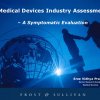KUALA LUMPUR, Malaysia, Aug. 27, 2014 /PRNewswire/ -- Higher disposable incomes and the rapid penetration of health insurance are fuelling the demand for medical devices in Asia-Pacific. With the rise of medical tourism, the inflow of patients requiring medical and surgical intervention is further increasing. The market will continue its steady ascent as the region's burgeoning population becomes increasingly vulnerable to age-related and non-communicable diseases, compelling significant investments in the domestic manufacturing of medical devices.
New analysis from Frost & Sullivan, 2014 Asia-Pacific Medical Devices Outlook, finds that the market earned revenues of US$53.13 billion in 2013 and estimates this to reach US$98.97 billion in 2018. The study, which analyses the opportunities, business models, medical device market revenues, and region-wise market, covers cardiac, orthopedic, wound care and wound closure, and minimally invasive surgery devices.
"The need for faster recovery, accuracy, and precision to ensure early discharge from hospitals will drive the development of new technology in medical device products," said Frost & Sullivan Healthcare Consultant Poornima Srinivasan. "Manufacturers are also turning to frugal innovation, designing 'as-is' products to meet the needs of a domestic market burdened by rising healthcare costs."
This is crucial as healthcare spending in most Asia-Pacific countries remains conservative, with tight budgets stalling consumer expenditure on expensive equipment. To counter this, manufacturers need to leverage proper distribution strategies and aggressively launch cost-effective yet high-quality, sustainable business products.
Contract manufacturing will become a common trend, since multinational products are exorbitantly priced and many governments have liberalized policies for domestic manufacturing. Partnering with ancillary services available in Asia-Pacific countries too could bring down the cost of products.
"As regional production gathers pace, and considering the multi-disciplinary nature of medical device technologies, industry integration with academia and hospitals is vital," noted Srinivasan. "Such collaboration will aid technology transfer, improve competitiveness, and ultimately strengthen industry understanding of healthcare and services needs in the region."
If you are interested in more information on this study, please send an e-mail to Donna Jeremiah, Corporate Communications, at [email protected], with your full name, company name, job title, telephone number, company e-mail address, company website, city, state and country.
2014 Asia-Pacific Medical Devices Outlook is part of the Advanced Medical Technologies (http://www.medtech.frost.com) Growth Partnership Service program. Frost & Sullivan's related studies include: Global Emerging Interventional Cardiac Devices Market, Endoscopy Devices Market in Australia, South Korea, and Southeast Asia, and Image-guided Surgery and Robot-assisted Surgery Market in Asia-Pacific. All studies included in subscriptions provide detailed market opportunities and industry trends evaluated following extensive interviews with market participants.
source: Frost & Sullivan
Change in Demographics and Surge in Domestic Manufacturing Drive Asia-Pacific Medical Devices Market Share with Twitter Share with LinkedIn

